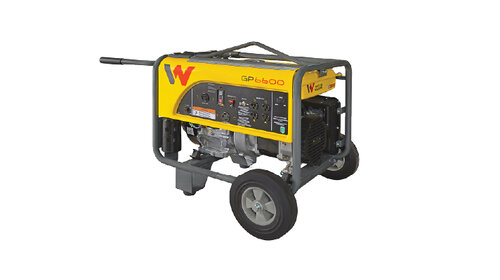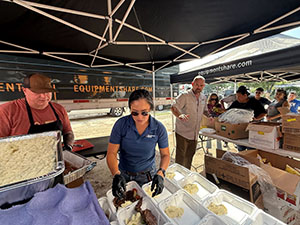Introduction to Generator Safety
Generators are powerful tools that provide essential power when and where you need it, whether you’re running a construction site, hosting an event or managing an emergency. However, with their power comes significant responsibility. If not handled correctly, generators can pose serious risks, including carbon monoxide poisoning, electrical hazards and fires. Whether you're a seasoned professional or using a generator for the first time, knowing how to operate it safely is crucial.
The Importance of Using Generators Safely
Safety should always be your top priority when operating a generator. Generators emit carbon monoxide (CO), an invisible, odorless gas that can be deadly if inhaled in large amounts. Electrical hazards are also a major concern, especially if the generator is not properly grounded or if you’re using it with faulty cables. Additionally, improper handling during refueling or overloading the generator can lead to fires. By adhering to safety guidelines, you protect yourself, those around you and your equipment.
Overview of Potential Hazards
Let’s break down the key risks associated with generators:
- Carbon Monoxide Poisoning: Generators produce CO as a byproduct of burning fuel. Without proper ventilation, CO can build up quickly, leading to poisoning. Symptoms of CO poisoning include dizziness, headaches and in severe cases, death.
- Electrical Hazards: Improper grounding or using damaged cords can result in electrical shocks, which can cause injury or even be fatal. Overloading the generator can also lead to electrical fires or damage to connected equipment.
- Fire Risks: Handling fuel near a hot engine, overfilling the fuel tank or operating a generator in an enclosed space can result in a fire. Always ensure proper refueling procedures and maintain adequate ventilation.
Following safety guidelines not only prevents these risks but also extends the life of your generator and ensures reliable performance when you need it most.
Selecting the Right Generator
Choosing the right generator is critical to safe and effective operation. Here’s what you need to consider:
Size and Power Output
The size and power output of the generator must align with your specific power needs. A generator that’s too small won’t handle your load, leading to overloading and potential equipment damage. On the other hand, an oversized generator may be inefficient and more costly to operate.
- Small to Medium Loads: For tasks like powering small tools, lights or household appliances, a portable generator with a lower power output will suffice. These are typically easier to transport and set up.
- Large-Scale Needs: For powering an entire construction site, large event or critical systems in a facility, you’ll need a generator with a higher power output. These generators are usually stationary and require more complex setup and maintenance.
Reliability and Maintenance
A reliable generator is essential, especially in critical situations like emergencies or high-demand environments. It’s not just about picking the right brand but ensuring the unit you choose has been properly maintained and is in top working condition.
- Well-Maintained Units: Always opt for generators that have been regularly serviced and checked for wear and tear. This reduces the risk of breakdowns and extends the life of the generator.
- EquipmentShare’s Quality Assurance: At EquipmentShare, every generator in our rental fleet undergoes rigorous maintenance checks to ensure it’s reliable and ready for use. This level of care minimizes the risk of failures and enhances safety during operation.
Generator Placement and Setup
Where and how you set up your generator plays a significant role in safety.
Safe Placement Guidelines
Generators should always be placed outdoors, in a well-ventilated area and at least 20 feet away from doors, windows and vents. This placement prevents carbon monoxide from entering enclosed spaces, which can be deadly.
- Avoid Enclosed Spaces: Never place a generator inside a building, garage or any enclosed area. Even with windows open, the risk of CO buildup is too high.
- Proper Ventilation: Ensure that the exhaust fumes from the generator can dissipate freely. Position the exhaust away from occupied areas to prevent CO exposure.
Proper Grounding Techniques
Grounding the generator is crucial to prevent electrical shocks. This involves connecting the generator to a grounding rod, which provides a safe path for electricity to discharge in case of a fault.
- How to Ground: Follow the manufacturer’s instructions to ground your generator correctly. Improper grounding can lead to severe electrical hazards.
- Using Ground Fault Circuit Interrupters (GFCIs): These devices can also help protect against electrical shocks by shutting off the circuit when they detect an imbalance in the electrical flow.
How to Operate a Generator Safely
Once your generator is set up, it’s essential to operate it correctly to ensure safety.
Starting and Stopping the Generator
- Starting the Generator: Before starting, disconnect all electrical loads. This prevents the generator from being overloaded at startup. Follow the manufacturer’s instructions to start the generator, which typically involves turning on the fuel valve, setting the choke, and pulling the starter cord or pressing the start button.
- Stopping the Generator: Disconnect all electrical loads before turning off the generator. This helps avoid damage to the generator and connected devices. Turn off the generator using the manufacturer's recommended procedure, usually involving switching off the power and closing the fuel valve.
Checking Fuel Levels and Refueling
Always check the fuel level before starting the generator. If you need to refuel, turn off the generator and allow it to cool down to avoid any risk of fire.
- Refueling Safely: Only refuel when the generator is cool. Use a proper fuel container and avoid spilling fuel on hot engine parts. Keep flammable materials away from the generator.
- Fuel Storage: Store fuel in approved containers and keep it in a well-ventilated area, away from living spaces.
Avoiding Overloading
To prevent overloading, make sure the combined wattage of all connected devices does not exceed the generator’s capacity.
- Using Extension Cords: Use heavy-duty, outdoor-rated extension cords that are capable of handling the load. Avoid using damaged cords, as they can cause electrical fires.
- Balancing the Load: Distribute the load evenly across the generator's circuits to avoid putting too much strain on one outlet.
Maintenance and Inspection Tips
Regular maintenance and inspections are vital to ensuring your generator remains in safe, working order.
Regular Inspections
Before each use, inspect the generator for signs of wear and tear. Pay special attention to cables, fuel lines and exhaust systems.
- Cables and Connections: Look for frayed wires or loose connections that could pose electrical hazards.
- Fuel Lines: Check for leaks or cracks, which could lead to fuel spills and fire risks.
- Exhaust Systems: Ensure the exhaust system is intact and free of obstructions to prevent dangerous gas buildup.
Scheduled Maintenance Practices
Follow the manufacturer’s recommended maintenance schedule, which typically includes regular oil changes, air filter replacements and spark plug inspections.
- Oil Changes: Regular oil changes keep the engine running smoothly and extend the life of the generator.
- Filter Replacements: Clean air and fuel filters prevent debris from entering the engine, which could cause damage.
Real-Time Monitoring
Using advanced telematics, like T3™ by EquipmentShare, you can monitor your generator’s performance in real-time. This technology alerts you to potential issues before they become serious, helping you maintain the generator in peak condition.
Emergency Procedures and Preparedness
Despite all precautions, emergencies can happen. Knowing how to respond is key to minimizing damage and ensuring safety.
Handling Malfunctions or Emergencies
If your generator malfunctions or if an emergency such as a fire occurs, having a plan in place can make all the difference.
- Fire Response: Keep a fire extinguisher rated for electrical and fuel fires nearby. In case of a fire, turn off the generator if it’s safe to do so and use the fire extinguisher to put out the flames.
- Power Surge: Disconnect all electrical loads immediately if you experience a power surge. Inspect the generator and connected equipment for damage before restarting.
Preparedness and Training
Being prepared means more than just having the right equipment. It’s also about knowing how to use it safely.
- Safety Training: Undergoing safety training can provide you with valuable knowledge and practical skills. These programs ensure you’re prepared to operate a generator safely and respond effectively in an emergency.
Generator Rentals
Operating a generator safely is not just about protecting yourself—it’s about ensuring the reliability of your equipment and the success of your project. From selecting the right generator to proper placement, operation and maintenance, each step is crucial to safe generator use. For those who need reliable, high-quality generators, EquipmentShare offers a range of rental options. When it comes to generator safety, don’t take chances—get the right equipment and keep everything running smoothly.

.svg)
.svg)














